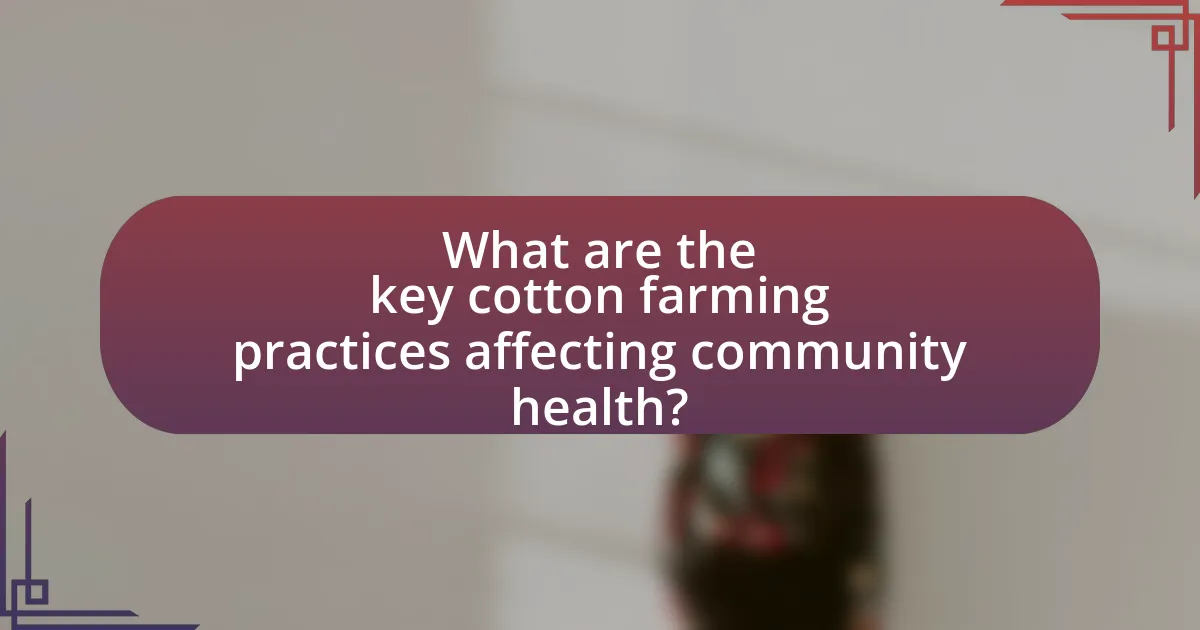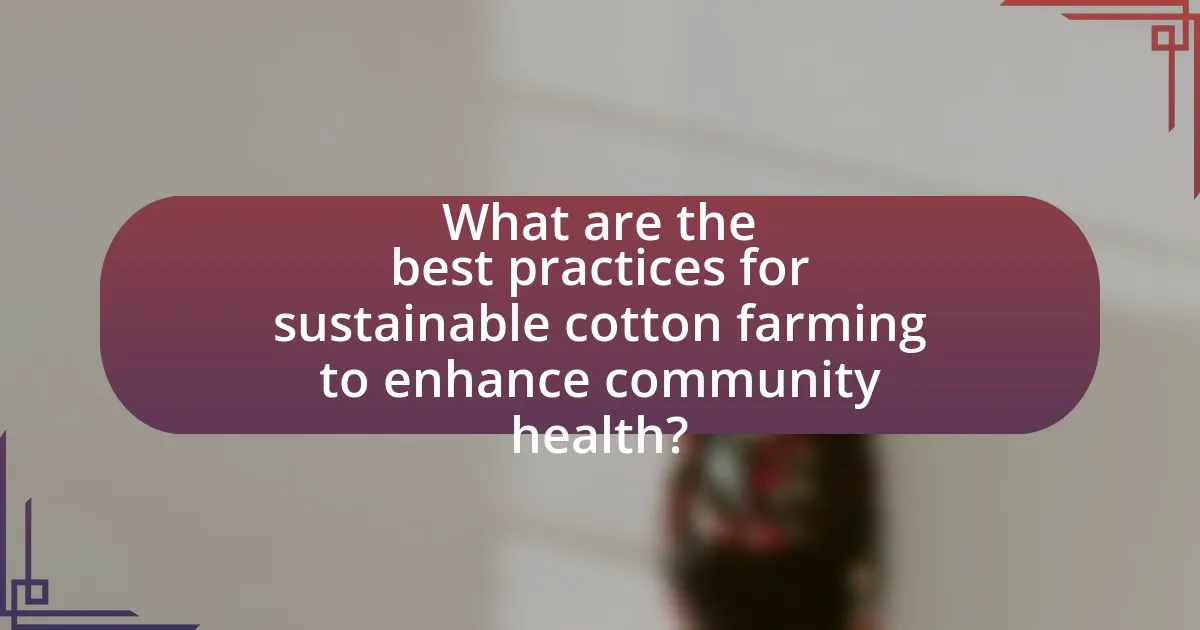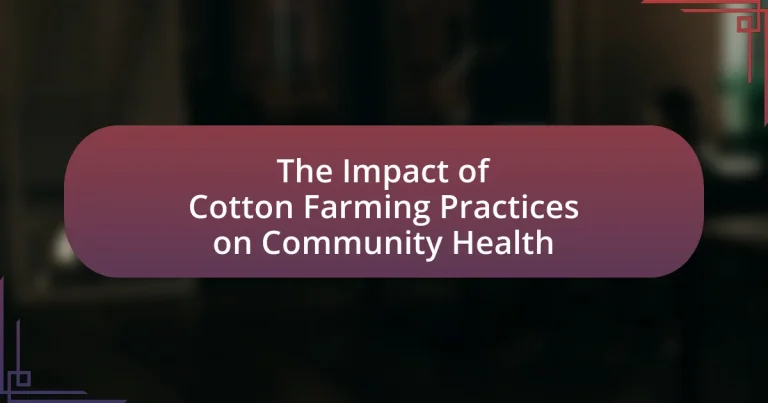The article examines the impact of cotton farming practices on community health, highlighting key factors such as pesticide use, water management, and soil health. It details how agricultural chemicals contribute to health issues like respiratory problems and skin irritations among farmworkers and nearby residents. The article also discusses the implications of soil degradation, monoculture, and labor practices on nutrition and overall community well-being. Furthermore, it emphasizes the importance of sustainable practices, such as integrated pest management and organic farming, in mitigating health risks and promoting healthier farming environments.

What are the key cotton farming practices affecting community health?
Key cotton farming practices affecting community health include the use of pesticides, water management, and soil health practices. The application of pesticides can lead to health issues such as respiratory problems and skin irritations among farmworkers and nearby residents due to chemical exposure. For instance, studies have shown that communities near cotton farms report higher incidences of pesticide-related illnesses. Water management practices, including irrigation methods, can impact local water quality, potentially leading to waterborne diseases if contaminated runoff occurs. Additionally, soil health practices, such as the use of synthetic fertilizers, can degrade soil quality and affect food safety, which in turn influences community nutrition and health outcomes.
How do agricultural chemicals used in cotton farming impact health?
Agricultural chemicals used in cotton farming negatively impact health by increasing the risk of various diseases and health conditions. Exposure to pesticides and herbicides, commonly used in cotton cultivation, has been linked to respiratory issues, skin irritations, and neurological disorders. For instance, a study published in the International Journal of Environmental Research and Public Health found that farmers exposed to these chemicals had higher incidences of chronic respiratory diseases and skin conditions compared to those not exposed. Additionally, the World Health Organization has classified certain pesticides as probable human carcinogens, indicating a potential link to cancer. These findings underscore the significant health risks associated with agricultural chemicals in cotton farming.
What specific chemicals are commonly used in cotton farming?
Common chemicals used in cotton farming include glyphosate, chlorpyrifos, and neonicotinoids. Glyphosate is a widely used herbicide for weed control, while chlorpyrifos is an insecticide that targets pests. Neonicotinoids are a class of insecticides that affect the nervous system of insects. These chemicals are prevalent due to their effectiveness in increasing cotton yields and managing pest populations. Studies have shown that the extensive use of these chemicals can lead to adverse health effects in communities surrounding cotton farms, including respiratory issues and developmental problems in children.
How do these chemicals affect local water sources?
Chemicals used in cotton farming, such as pesticides and fertilizers, negatively affect local water sources by contaminating them through runoff and leaching. This contamination can lead to elevated levels of harmful substances like nitrates and phosphates in nearby rivers and groundwater, which can disrupt aquatic ecosystems and pose health risks to communities relying on these water sources. For instance, studies have shown that pesticide runoff can lead to toxic concentrations in water bodies, harming fish populations and reducing biodiversity. Additionally, high nitrate levels in drinking water can cause health issues such as methemoglobinemia, particularly in infants.
What role does soil health play in community health outcomes?
Soil health significantly influences community health outcomes by affecting food quality, water quality, and ecosystem services. Healthy soil promotes the growth of nutritious crops, which directly impacts the dietary health of community members. For instance, research indicates that soil rich in organic matter can enhance the nutrient content of food, leading to better health outcomes such as reduced rates of malnutrition and related diseases. Additionally, healthy soil contributes to improved water filtration and reduced runoff, which decreases the risk of waterborne diseases. A study published in the journal “Environmental Health Perspectives” highlights that communities with degraded soil often face higher incidences of health issues linked to poor agricultural practices and environmental contamination. Thus, maintaining soil health is crucial for fostering overall community well-being.
How does soil degradation from cotton farming practices affect nutrition?
Soil degradation from cotton farming practices negatively affects nutrition by reducing the soil’s ability to support healthy crop growth. This degradation often leads to lower yields and diminished nutrient content in food crops, which directly impacts the nutritional quality of the food available to communities. For instance, studies have shown that soil erosion and nutrient depletion can result in crops that are deficient in essential vitamins and minerals, thereby increasing the risk of malnutrition among populations reliant on these crops for sustenance.
What are the long-term effects of monoculture on soil health?
Monoculture negatively impacts soil health over the long term by depleting soil nutrients and reducing biodiversity. Continuous planting of a single crop, such as cotton, leads to nutrient exhaustion, particularly nitrogen, phosphorus, and potassium, which are essential for plant growth. Research indicates that monoculture systems can result in a 30% decrease in soil organic matter over time, diminishing soil structure and fertility. Additionally, the lack of crop diversity fosters the proliferation of pests and diseases, further degrading soil quality. Studies have shown that soils under monoculture are more prone to erosion and compaction, which can lead to reduced water retention and increased runoff, ultimately harming the ecosystem.
How do labor practices in cotton farming influence community well-being?
Labor practices in cotton farming significantly influence community well-being by affecting economic stability, health outcomes, and social structures. For instance, exploitative labor practices, such as low wages and poor working conditions, can lead to increased poverty levels within communities, reducing access to essential services like healthcare and education. Research indicates that communities reliant on cotton farming often experience higher rates of health issues, including pesticide exposure-related illnesses, which further deteriorate community health. Additionally, when labor practices prioritize fair wages and safe working conditions, communities benefit from improved economic conditions, leading to better health outcomes and enhanced social cohesion.
What are the health risks associated with labor conditions in cotton fields?
Labor conditions in cotton fields pose significant health risks, including exposure to harmful pesticides, heat stress, and musculoskeletal injuries. Workers often handle toxic chemicals without adequate protective gear, leading to acute and chronic health issues such as respiratory problems, skin conditions, and potential long-term effects like cancer. Additionally, the physically demanding nature of cotton harvesting can result in injuries related to repetitive strain and poor ergonomics. Studies indicate that agricultural workers are at a higher risk for these health complications due to inadequate safety measures and lack of access to healthcare.
How does fair labor practice impact community health?
Fair labor practices significantly enhance community health by ensuring safe working conditions, fair wages, and access to healthcare for workers. When labor practices are fair, workers experience reduced stress and improved mental health, which positively affects their families and communities. For instance, studies have shown that fair labor conditions in agriculture, such as those implemented in sustainable cotton farming, lead to lower rates of occupational injuries and illnesses. Additionally, communities benefit from increased economic stability, as fair wages allow workers to invest in healthcare and education, further promoting overall health outcomes.

What are the broader implications of cotton farming on public health?
Cotton farming has significant broader implications on public health, primarily due to the extensive use of pesticides and fertilizers. These chemicals can contaminate water supplies and soil, leading to health issues such as respiratory problems, skin diseases, and long-term effects like cancer in agricultural communities. For instance, a study published in the journal Environmental Health Perspectives found that exposure to certain pesticides used in cotton farming is linked to increased rates of neurological disorders among farmworkers. Additionally, the runoff from cotton fields can lead to waterborne diseases, affecting not only farmers but also surrounding populations. The World Health Organization has reported that pesticide exposure is a critical public health concern, particularly in developing countries where cotton farming is prevalent.
How does cotton farming contribute to environmental health issues?
Cotton farming contributes to environmental health issues primarily through the extensive use of pesticides and fertilizers, which can contaminate soil and water sources. These chemicals, often used in large quantities to combat pests and enhance growth, can lead to soil degradation and water pollution, adversely affecting local ecosystems and human health. For instance, studies have shown that runoff from cotton fields can carry harmful substances into nearby rivers and lakes, leading to biodiversity loss and health risks for communities relying on these water sources. Additionally, the high water consumption associated with cotton farming can deplete local water supplies, exacerbating drought conditions and impacting agricultural sustainability.
What are the links between cotton farming and air quality?
Cotton farming is linked to air quality through the release of pollutants and particulate matter during cultivation and processing. The use of pesticides and fertilizers in cotton farming contributes to the emission of volatile organic compounds (VOCs), which can degrade air quality. Additionally, the dust generated from land preparation and harvesting can increase airborne particulate matter, negatively impacting respiratory health. Studies have shown that regions with intensive cotton farming often experience higher levels of air pollution, correlating with increased respiratory issues among local populations.
How does cotton farming affect biodiversity in the community?
Cotton farming negatively affects biodiversity in the community by reducing habitat availability for various species. The extensive use of pesticides and fertilizers in cotton cultivation leads to soil degradation and water pollution, which further diminishes local flora and fauna. Studies indicate that monoculture practices in cotton farming can result in a significant decline in insect populations, including pollinators, which are crucial for ecosystem balance. For instance, research published in the journal “Agriculture, Ecosystems & Environment” highlights that regions with intensive cotton farming experience a 30% reduction in species diversity compared to more diverse agricultural systems. This loss of biodiversity can disrupt food webs and ecological interactions, ultimately impacting community health and resilience.
What are the socio-economic impacts of cotton farming on community health?
Cotton farming significantly impacts community health through both socio-economic channels and environmental factors. The reliance on pesticides and fertilizers in cotton cultivation can lead to health issues such as respiratory problems and skin diseases among farmworkers and nearby residents. For instance, a study published in the International Journal of Environmental Research and Public Health found that exposure to pesticides is linked to increased rates of chronic illnesses in agricultural communities. Additionally, the economic benefits of cotton farming, such as job creation and income generation, can improve access to healthcare and education, thereby enhancing overall community health. However, these benefits are often offset by the health risks associated with chemical exposure and the socio-economic disparities that arise from unequal access to resources.
How does cotton farming influence access to healthcare in rural areas?
Cotton farming significantly influences access to healthcare in rural areas by affecting local economies and resource allocation. The income generated from cotton farming can enhance financial stability, allowing families to invest in healthcare services. For instance, a study by the International Cotton Advisory Committee found that increased cotton production correlates with improved economic conditions, which can lead to better access to medical facilities and services. Additionally, the reliance on cotton farming may divert attention and resources away from healthcare infrastructure, as communities prioritize agricultural investments over health services. This dual impact illustrates how cotton farming can both improve and hinder access to healthcare in rural settings.
What are the economic benefits of sustainable cotton farming practices?
Sustainable cotton farming practices provide significant economic benefits by reducing costs and increasing profitability for farmers. These practices, such as integrated pest management and organic farming, lower input costs associated with chemical fertilizers and pesticides, leading to higher profit margins. For instance, a study by the International Cotton Advisory Committee found that farmers adopting sustainable practices can reduce their production costs by up to 30%. Additionally, sustainable cotton often commands higher market prices due to increasing consumer demand for eco-friendly products, further enhancing farmers’ income. This dual advantage of cost reduction and premium pricing illustrates the economic viability of sustainable cotton farming.
How can community health be improved through better cotton farming practices?
Community health can be improved through better cotton farming practices by reducing pesticide exposure and promoting sustainable agricultural methods. Implementing integrated pest management (IPM) techniques minimizes the use of harmful chemicals, which can lead to lower rates of pesticide-related illnesses among farmworkers and nearby residents. For instance, a study published in the Journal of Environmental Health found that communities utilizing IPM reported a 30% decrease in health issues related to pesticide exposure. Additionally, adopting organic farming practices can enhance soil health and water quality, further contributing to the overall well-being of the community. Research from the Organic Trade Association indicates that organic farming can reduce water contamination by up to 90%, thereby improving public health outcomes.
What role do local governments play in regulating cotton farming practices?
Local governments play a crucial role in regulating cotton farming practices by establishing and enforcing agricultural policies, zoning laws, and environmental regulations. These regulations are designed to ensure sustainable farming practices, protect local ecosystems, and safeguard community health. For instance, local governments may implement guidelines on pesticide use, irrigation methods, and crop rotation to minimize environmental impact and promote soil health. Additionally, they often collaborate with agricultural extension services to provide farmers with education on best practices, thereby enhancing productivity while reducing health risks associated with chemical exposure.
How can education and awareness improve health outcomes related to cotton farming?
Education and awareness can significantly improve health outcomes related to cotton farming by equipping farmers with knowledge about safe agricultural practices and the risks associated with pesticide use. When farmers are educated on integrated pest management and organic farming techniques, they can reduce their reliance on harmful chemicals, which in turn decreases exposure to toxic substances that can lead to health issues such as respiratory problems and skin diseases. Studies have shown that regions with higher levels of farmer education report lower incidences of pesticide-related illnesses. For instance, a study published in the Journal of Environmental Health found that educational interventions reduced pesticide exposure by 30% among cotton farmers. Thus, enhancing education and awareness directly correlates with improved health outcomes in cotton farming communities.

What are the best practices for sustainable cotton farming to enhance community health?
The best practices for sustainable cotton farming that enhance community health include implementing organic farming methods, utilizing integrated pest management (IPM), and promoting fair labor practices. Organic farming reduces the use of harmful pesticides and fertilizers, which can lead to better air and water quality, directly benefiting community health. IPM strategies minimize chemical inputs by using natural pest control methods, thereby reducing exposure to toxic substances for both farmers and nearby residents. Additionally, fair labor practices ensure that workers receive fair wages and safe working conditions, contributing to the overall well-being of the community. These practices collectively support healthier ecosystems and improve the quality of life for those involved in and affected by cotton farming.
How can integrated pest management improve health outcomes?
Integrated pest management (IPM) can improve health outcomes by reducing the reliance on chemical pesticides, which can pose health risks to farmworkers and nearby communities. By employing strategies such as biological control, habitat manipulation, and the use of resistant crop varieties, IPM minimizes pesticide exposure and its associated health hazards. Research indicates that communities utilizing IPM practices experience lower incidences of pesticide-related illnesses, as evidenced by a study published in the Journal of Agricultural and Environmental Ethics, which found a significant reduction in acute pesticide poisoning cases in regions that adopted IPM compared to those that did not. This approach not only protects human health but also promotes environmental sustainability, further contributing to overall community well-being.
What are the benefits of using organic farming methods in cotton production?
Using organic farming methods in cotton production significantly reduces chemical pesticide use, which benefits both environmental health and community well-being. Organic cotton farming employs natural pest control and organic fertilizers, minimizing harmful chemical exposure to farmers and surrounding communities. Research indicates that organic cotton farming can lead to a 30% reduction in pesticide-related health issues among agricultural workers, as reported by the World Health Organization. Additionally, organic practices enhance soil health and biodiversity, contributing to sustainable agricultural ecosystems that support community resilience and food security.
How does crop rotation contribute to healthier farming practices?
Crop rotation contributes to healthier farming practices by enhancing soil fertility and reducing pest and disease pressures. By alternating different crops in a specific sequence, farmers can improve nutrient cycling, as different plants have varying nutrient requirements and contributions. For instance, legumes can fix nitrogen in the soil, benefiting subsequent crops. Research indicates that crop rotation can lead to a 10-20% increase in crop yields compared to monoculture systems, as it disrupts pest life cycles and reduces the buildup of pathogens. This practice not only promotes sustainable agriculture but also supports community health by minimizing the need for chemical fertilizers and pesticides, which can have harmful effects on both the environment and human health.
What community initiatives can support healthier cotton farming practices?
Community initiatives that can support healthier cotton farming practices include the establishment of cooperative farming groups, educational programs on sustainable agriculture, and the promotion of organic cotton certification. Cooperative farming groups enable farmers to share resources, knowledge, and best practices, which can lead to improved farming techniques and reduced chemical usage. Educational programs can inform farmers about integrated pest management and soil health, which are essential for sustainable cotton production. Additionally, promoting organic cotton certification can incentivize farmers to adopt environmentally friendly practices, as organic cotton farming reduces the reliance on harmful pesticides and fertilizers. These initiatives collectively contribute to healthier farming practices, benefiting both the environment and community health.
How can local farmers collaborate to promote sustainable practices?
Local farmers can collaborate to promote sustainable practices by forming cooperatives that share resources, knowledge, and best practices. These cooperatives enable farmers to collectively invest in sustainable technologies, such as drip irrigation and organic fertilizers, which have been shown to reduce water usage and chemical runoff. Research indicates that cooperative farming can lead to a 20% increase in sustainable crop yields, as evidenced by a study published in the Journal of Sustainable Agriculture. By working together, farmers can also engage in joint marketing efforts to promote sustainably grown cotton, thereby increasing consumer awareness and demand for eco-friendly products.
What resources are available for farmers to transition to sustainable practices?
Farmers can access various resources to transition to sustainable practices, including government programs, educational workshops, and financial assistance. For instance, the USDA offers the Environmental Quality Incentives Program (EQIP), which provides financial and technical assistance to farmers implementing conservation practices. Additionally, organizations like the Sustainable Agriculture Research and Education (SARE) program offer grants and resources for research and education on sustainable farming methods. Research indicates that adopting sustainable practices can lead to improved soil health and reduced chemical use, ultimately benefiting community health and the environment.
What practical steps can communities take to mitigate health risks from cotton farming?
Communities can mitigate health risks from cotton farming by implementing integrated pest management (IPM) practices, promoting organic farming, and providing education on safe pesticide use. IPM reduces reliance on harmful chemicals by using biological controls and crop rotation, which has been shown to decrease pesticide exposure and improve health outcomes. Organic farming eliminates synthetic pesticides and fertilizers, leading to lower health risks associated with chemical exposure. Additionally, educating farmers and workers about the safe handling and application of pesticides can significantly reduce incidents of pesticide poisoning, as evidenced by studies indicating that proper training can decrease health-related issues by up to 50%.





